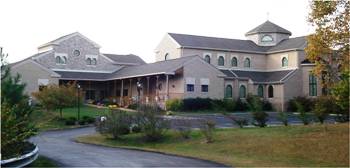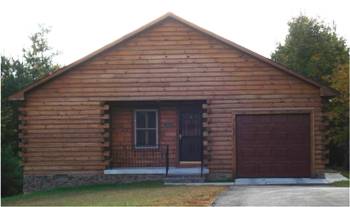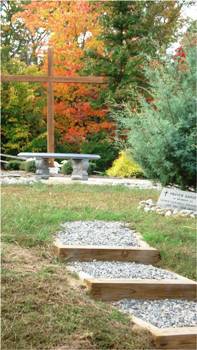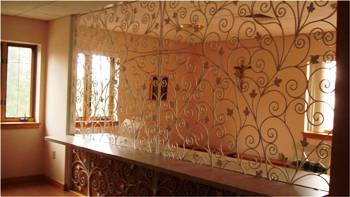The Poor Clares![]() (Description of the life of Poor Clares
(Description of the life of Poor Clares
at Barhamsville, VA)
The Poor Clares is a generic term given to the Order of St. Clare, which contains sixteen branches in 70 countries around the world. A Second Franciscan Order originally founded by St. Clare of Assisi and St. Francis of Assisi in 1212 in Italy, the Order has experienced various reforms resulting in different branches (variations) of Poor Clares. In the 14 th century, St. Colette reformed the order with a return to a stricter adherence to the Observance of Primitive Rule of St. Clare and founded new monasteries leading to the branch, the Poor Clare Colettines. The first Poor Clare Colettines came from Germany in 1877 and settled in Cleveland, Ohio. That foundation in Cleveland established thirteen Monasteries within the United States. In 1956, Poor Clares from Cleveland established a foundation in Newport News, Virginia, the first Poor Clare Colettines in Virginia. However, due to the upheaval in church and society occurring during the 1960s reforms within the Catholic Church and the Second Vatican Council, the Newport News foundation almost disbanded with only one Sister keeping her Solemn Vows. The Newport News foundation was re-founded in 1972 by the Poor Clare Colettines in Roswell, New Mexico.
 The Poor Clare Colettines decided to leave Newport News because of the neighborhoods, the noise of the city that has grown up around them, and the deteriorating structural integrity of their old building. In 2003 they purchased land in Barhamsville, Virginia from the Chesapeake Forestry, which they named Mount Saint Francis. With funds from selling the monastery in Newport News and donations from friends and benefactors, the Sisters began construction of the monastery that they named Bethlehem, meaning house of bread. The monastery property in Newport News was bought by the Hope Community Church and turned into one of its ministries, the LivingStone Monastery. Construction of the Bethlehem Monastery was temporarily halted in late 2003 due to hurricane Isabel. The Poor Clares went to stay with the Sisters of the Visitation of the Holy Mary Monte Maria Monastery in Rockville, Virginia. It was after Isabel that the Poor Clares witnessed a “little miracle”; all of the windows in the Monastery that had only been set in but not secured remained in place and intact despite the obvious signs of the power of the storm. The current community of Poor Clare Colettines consists of thirteen Sisters, including one Postulant. They range in ages from 28 to 81 and are from a variety of cultural backgrounds, including European, American, Indian, and Filipino. The community enjoyed its largest membership in the late 1990s with sixteen Sisters.
The Poor Clare Colettines decided to leave Newport News because of the neighborhoods, the noise of the city that has grown up around them, and the deteriorating structural integrity of their old building. In 2003 they purchased land in Barhamsville, Virginia from the Chesapeake Forestry, which they named Mount Saint Francis. With funds from selling the monastery in Newport News and donations from friends and benefactors, the Sisters began construction of the monastery that they named Bethlehem, meaning house of bread. The monastery property in Newport News was bought by the Hope Community Church and turned into one of its ministries, the LivingStone Monastery. Construction of the Bethlehem Monastery was temporarily halted in late 2003 due to hurricane Isabel. The Poor Clares went to stay with the Sisters of the Visitation of the Holy Mary Monte Maria Monastery in Rockville, Virginia. It was after Isabel that the Poor Clares witnessed a “little miracle”; all of the windows in the Monastery that had only been set in but not secured remained in place and intact despite the obvious signs of the power of the storm. The current community of Poor Clare Colettines consists of thirteen Sisters, including one Postulant. They range in ages from 28 to 81 and are from a variety of cultural backgrounds, including European, American, Indian, and Filipino. The community enjoyed its largest membership in the late 1990s with sixteen Sisters.
 The Bethlehem Monastery on Mt. St. Francis has a public chapel, a chapter room, a refectory (dining room), a kitchen and bakery, a community room, cells (bedrooms), a shower/tub room, a laundry room, two visiting rooms, offices, and a gift shop. The public chapel contains the nun’s choir (where they remain hidden during Mass), a sacristy, and the grille. The grille separates the main body of the church from the sanctuary and the enclosed area of the nun’s choir and is part of the Poor Clares’ Papal enclosure. Papal enclosure is also notable in the large visiting room where the separating grille was brought from Newport News and is symbolic of the vine and branch metaphor in the Gospel of John. The Mt. St. Francis property has trails for hiking, a pond, a small log cabin for the Sister’s Chaplain, and the Mt. Alverna cemetery. The cemetery holds two Sisters brought from the Newport News Monastery. When a Sister dies, their chaplain or the Bishop of the Richmond Catholic Diocese presides over the funeral ceremony. Throughout the Bethlehem Monastery are various religious artworks, icons, statues, and a prayer garden. Additionally, the architecture throughout the Monastery is of the Romanesque design and details, such as an arched portico and rose windows, resemble Assisi’s San Damiano, home of St. Clare. As is typical of most monasteries, the building is shaped around a courtyard. One of the Sisters in the current community is an artist whose work is exhibited and for sale in the gift shop, and the monastery has an organ. Additionally, the Sisters have two dogs, Reba and Prince, and at one time had two cats.
The Bethlehem Monastery on Mt. St. Francis has a public chapel, a chapter room, a refectory (dining room), a kitchen and bakery, a community room, cells (bedrooms), a shower/tub room, a laundry room, two visiting rooms, offices, and a gift shop. The public chapel contains the nun’s choir (where they remain hidden during Mass), a sacristy, and the grille. The grille separates the main body of the church from the sanctuary and the enclosed area of the nun’s choir and is part of the Poor Clares’ Papal enclosure. Papal enclosure is also notable in the large visiting room where the separating grille was brought from Newport News and is symbolic of the vine and branch metaphor in the Gospel of John. The Mt. St. Francis property has trails for hiking, a pond, a small log cabin for the Sister’s Chaplain, and the Mt. Alverna cemetery. The cemetery holds two Sisters brought from the Newport News Monastery. When a Sister dies, their chaplain or the Bishop of the Richmond Catholic Diocese presides over the funeral ceremony. Throughout the Bethlehem Monastery are various religious artworks, icons, statues, and a prayer garden. Additionally, the architecture throughout the Monastery is of the Romanesque design and details, such as an arched portico and rose windows, resemble Assisi’s San Damiano, home of St. Clare. As is typical of most monasteries, the building is shaped around a courtyard. One of the Sisters in the current community is an artist whose work is exhibited and for sale in the gift shop, and the monastery has an organ. Additionally, the Sisters have two dogs, Reba and Prince, and at one time had two cats.

The Poor Clare Sisters lead a contemplative lifestyle which revolves around the Eucharist, the Liturgy of the Hours, private meditation, and spiritual reading. They hold public Mass at 8am everyday. The Sisters have Exposition after Mass Monday through Friday and Exposition with the Rosary at 3:30 on Sundays. The Exposition is the occasion when the Eucharist is exposed for public viewing in a monstrance. On Thursdays the Sisters have the Benediction Blessing. The Poor Clare Colettines’ daily schedule is distinctive in two ways: they rise for prayer in the middle of the night and they practice a method of fasting that consists of one large meal and two smaller meals. The Sisters’ day begins at 12:20 am when they rise for Matins (Midnight Prayer).
The Sisters then return to bed and rise again at 4:40 for Lauds (Morning Prayer). At 5:50 the Sisters have coffee and home baked bread; this constitutes one of the two smaller meals the Sisters take through out the day. After coffee, the Sisters have Lectio Divinia (Spiritual Reading) from 6:30 to 7:30. After Lectio, the Sisters engage in Terce (Mid-morning Prayer) until 8:00 when public Mass is observed. At 9:00 the Sisters’ morning work begins; it ends at 11:25 for Sext (Midday Prayer). After Sext, the Sisters have the largest meal of their day, dinner at 12:00. As is customary, the Sisters take their meals in silence. After dinner ends at 1:30, the Sisters have Rosary and None (Mid-afternoon Prayer). At 2:15 the Sisters resume work until 4:20 at which time they have Vespers (Evening Prayer) and Adoration. At 5:30, the Sisters have their second smaller meal of the day, Collation. After collation ends at 6:30 the Sisters have recreation until Compline (Night Prayer) at 7:30. During recreation the Sisters, who observe silence during meals and their work, will speak openly. On a rare occasion the Sisters will watch a DVD, but the main focus of recreation is to speak and connect with others. After Compline ends, the Sisters retire at 8:45.
 When the Sisters work, they sew clothing and habits, do laundry, cook, bake, garden, clean, set-up alters, and greet visitors. Most of the jobs are set positions but some of the more challenging jobs like cooking and greeting visitors alternate weekly. The Sisters are able to lead their contemplative lifestyle with the help of benefactors, donations, profits from the gift shop, and their Catholic Host distribution company. In the distribution company the Sisters act as a “middleman” for the Host wholesaler and various Catholic Churches in the area. However, the majority of their funds come from donations. The Sisters hold council meetings and chapter meetings. The council consists of the Mother Superior or Abbess, her second in command, and one other Sister. A chapter meeting is called when the input of the whole community (all the Sisters) is needed. Additionally, the Poor Clares have a Novitiate/Postulant program.
When the Sisters work, they sew clothing and habits, do laundry, cook, bake, garden, clean, set-up alters, and greet visitors. Most of the jobs are set positions but some of the more challenging jobs like cooking and greeting visitors alternate weekly. The Sisters are able to lead their contemplative lifestyle with the help of benefactors, donations, profits from the gift shop, and their Catholic Host distribution company. In the distribution company the Sisters act as a “middleman” for the Host wholesaler and various Catholic Churches in the area. However, the majority of their funds come from donations. The Sisters hold council meetings and chapter meetings. The council consists of the Mother Superior or Abbess, her second in command, and one other Sister. A chapter meeting is called when the input of the whole community (all the Sisters) is needed. Additionally, the Poor Clares have a Novitiate/Postulant program.
The Sisters celebrate holydays as well as American holidays. During holyday celebrations the focus is on the Liturgy of the Hours, but the ceremonies are more festive, with altar decorations, feasts, singing, speaking during meals and extra recreation time. The Poor Clares typically observe silence during meals, during work speak only when necessary, and utilize a small amount of sign language. For American holidays the Sisters will decorate, eat novelties, and speak openly. The Sisters do not typically celebrate birthdays unless a Sister has turned 80; however, the Sisters will celebrate anniversaries of their Solemn Vows in the form of Jubilee. Jubilees, marked by Silver for 25 years and Gold for 50 years, are a three day public celebration. Additionally, each Sister privately renews her vows on their personal anniversary each year. Some celebrations distinctive to the Poor Clares are the Feast of St. Francis, commemorated on October 4 th, and the Feast of St. Clare, their Foundress, celebrated on August 11 th. Once a year the Poor Clares observe Holy Thursday, with the ceremony of the Foot Washing. In this ceremony, which takes place in the chapter room, the Mother Superior or Abbess gives the reading of the gospel account of how Jesus washed the feet of his twelve apostles and then the Mother Superior or Abbess washes one foot of each Sister.
The Poor Clares Colettines celebrate public Mass at 8:00 every day with the Exposition following Mass Monday through Friday and the Exposition with the Rosary at 3:30 on Sunday. Approximately, one to five people attend the weekly Mass, with around ten on Saturday and fifteen on Sunday. Typically the Chapel is full with around 30 people on Christmas and Easter. The Mass serves people in the surrounding New Kent County.
Bethlehem Monastery of Poor Clares
5500 Holly Fork Road
Barhamsville, VA 23011
(757)-566-1684
Sources:
Mother Mary Clare, Abbess
Poor Clares website
Profile Prepared by Amanda Tellefsen
October, 2009
